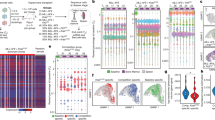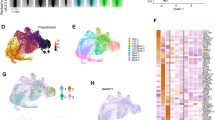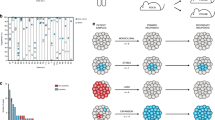Abstract
Cancer stem cells or tumour-propagating cells (TPCs) have been identified for a number of cancers, but data pertaining to their existence in lymphoma so far remain elusive. We show for the first time that a small subset of cells purified from human anaplastic lymphoma kinase (ALK)-positive and -negative, anaplastic large cell lymphoma cell lines and primary patient tumours using the side population (SP) technique have serial tumour-propagating capacity both in vitro and in vivo; they give rise to both themselves and the bulk tumour population as well as supporting growth of the latter through the production of soluble factors. In vivo serial dilution assays utilising a variety of model systems inclusive of human cell lines, primary human tumours and nucleophosmin (NPM)-ALK-induced murine tumours demonstrate the TPC frequency to vary from as many as 1/54 to 1/1336 tumour cells. In addition, the SP cells express higher levels of pluripotency-associated transcription factors and are enriched for a gene expression profile consistent with early thymic progenitors. Finally, our data show that the SP cells express higher levels of the NPM-ALK oncogene and are sensitive to an ALK inhibitor.
This is a preview of subscription content, access via your institution
Access options
Subscribe to this journal
Receive 50 print issues and online access
$259.00 per year
only $5.18 per issue
Buy this article
- Purchase on Springer Link
- Instant access to full article PDF
Prices may be subject to local taxes which are calculated during checkout




Similar content being viewed by others
References
Al-Hajj M, Wicha MS, Benito-Hernandez A, Morrison SJ, Clarke MF . Prospective identification of tumorigenic breast cancer cells. Proc Natl Acad Sci USA 2003; 100: 3983–3988.
Lapidot T, Sirard C, Vormoor J, Murdoch B, Hoang T, Caceres-Cortes J et al. A cell initiating human acute myeloid leukaemia after transplantation into SCID mice. Nature 1994; 367: 645–648.
O'Brien CA, Pollett A, Gallinger S, Dick JE . A human colon cancer cell capable of initiating tumour growth in immunodeficient mice. Nature 2007; 445: 106–110.
Singh SK, Clarke ID, Terasaki M, Bonn VE, Hawkins C, Squire J et al. Identification of a cancer stem cell in human brain tumors. Cancer Res 2003; 63: 5821–5828.
Cobaleda C, Jochum W, Busslinger M . Conversion of mature B cells into T cells by dedifferentiation to uncommitted progenitors. Nature 2007; 449: 473–477.
Visvader JE . Cells of origin in cancer. Nature 2011; 469: 314–322.
Morris SW, Kirstein MN, Valentine MB, Dittmer KG, Shapiro DN, Saltman DL et al. Fusion of a kinase gene, ALK, to a nucleolar protein gene, NPM, in non-Hodgkin's lymphoma. Science 1994; 263: 1281–1284.
Turner SD, Alexander DR . Fusion tyrosine kinase mediated signalling pathways in the transformation of haematopoietic cells. Leukemia 2006; 20: 572–582.
Chiarle R, Gong JZ, Guasparri I, Pesci A, Cai J, Liu J et al. NPM-ALK transgenic mice spontaneously develop T-cell lymphomas and plasma cell tumors. Blood 2003; 101: 1919–1927.
Jager R, Hahne J, Jacob A, Egert A, Schenkel J, Wernert N et al. Mice transgenic for NPM-ALK develop non-Hodgkin lymphomas. Anticancer Res 2005; 25: 3191–3196.
Turner SD, Merz H, Yeung D, Alexander DR . CD2 promoter regulated nucleophosmin-anaplastic lymphoma kinase in transgenic mice causes B lymphoid malignancy. Anticancer Res 2006; 26: 3275–3279.
Turner SD, Tooze R, Maclennan K, Alexander DR . Vav-promoter regulated oncogenic fusion protein NPM-ALK in transgenic mice causes B-cell lymphomas with hyperactive Jun kinase. Oncogene 2003; 22: 7750–7761.
Turner SD, Alexander DR . What have we learnt from mouse models of NPM-ALK-induced lymphomagenesis? Leukemia 2005; 19: 1128–1134.
Goodell MA, Brose K, Paradis G, Conner AS, Mulligan RC . Isolation and functional properties of murine hematopoietic stem cells that are replicating in vivo. J Exp Med 1996; 183: 1797–1806.
Golebiewska A, Brons NH, Bjerkvig R, Niclou SP . Critical appraisal of the side population assay in stem cell and cancer stem cell research. Cell Stem Cell 2011; 8: 136–147.
Hu Y, Smyth GK . ELDA: extreme limiting dilution analysis for comparing depleted and enriched populations in stem cell and other assays. J Immunol Methods 2009; 347: 70–78.
Quintana E, Shackleton M, Sabel MS, Fullen DR, Johnson TM, Morrison SJ . Efficient tumour formation by single human melanoma cells. Nature 2008; 456: 593–598.
Kelly PN, Dakic A, Adams JM, Nutt SL, Strasser A . Tumor growth need not be driven by rare cancer stem cells. Science 2007; 317: 337.
Christensen JG, Zou HY, Arango ME, Li Q, Lee JH, McDonnell SR et al. Cytoreductive antitumor activity of PF-2341066, a novel inhibitor of anaplastic lymphoma kinase and c-Met, in experimental models of anaplastic large-cell lymphoma. Mol Cancer The. 2007; 6 (12 Pt 1): 3314–3322.
Georgantas RW 3rd, Tanadve V, Malehorn M, Heimfeld S, Chen C, Carr L et al. Microarray and serial analysis of gene expression analyses identify known and novel transcripts overexpressed in hematopoietic stem cells. Cancer Res 2004; 64: 4434–4441.
Doulatov S, Notta F, Eppert K, Nguyen LT, Ohashi PS, Dick JE . Revised map of the human progenitor hierarchy shows the origin of macrophages and dendritic cells in early lymphoid development. Nat Immunol 2010; 11: 585–593.
Notta F, Doulatov S, Laurenti E, Poeppl A, Jurisica I, Dick JE . Isolation of single human hematopoietic stem cells capable of long-term multilineage engraftment. Science 2011; 333: 218–221.
Dick JE . Stem cell concepts renew cancer research. Blood 2008; 112: 4793–4807.
Wang X, Werneck MB, Wilson BG, Kim HJ, Kluk MJ, Thom CS et al. TCR-dependent transformation of mature memory phenotype T cells in mice. J Clin Invest 2011; 121: 3834–3845.
Gibbs KD Jr., Jager A, Crespo O, Goltsev Y, Trejo A, Richard CE et al. Decoupling of tumor-initiating activity from stable immunophenotype in HoxA9-Meis1-driven AML. Cell Stem Cell 2012; 10: 210–217.
Gelebart P, Hegazy SA, Wang P, Bone KM, Anand M, Sharon D et al. Aberrant expression and biological significance of Sox2, an embryonic stem cell transcriptional factor, in ALK-positive anaplastic large cell lymphoma. Blood Cancer J 2012; 2: e82.
Hanahan D, Weinberg RA . Hallmarks of cancer: the next generation. Cell, 2011; 144 (5): 646–674.
Benharroch D, Meguerian-Bedoyan Z, Lamant L, Amin C, Brugieres L, Terrier-Lacombe MJ et al. ALK-positive lymphoma: a single disease with a broad spectrum of morphology. Blood 1998; 91: 2076–2084.
Swerdlow SH . WHO Classification of Tumours of Haematopoietic and Lymphoid Tissues. International Agency for Research on Cancer: Lyon, 2008. p 439.
Pearson JD, Lee JK, Bacani JT, Lai R, Ingham RJ . NPM-ALK and the JunB transcription factor regulate the expression of cytotoxic molecules in ALK-positive, anaplastic large cell lymphoma. Int J Clin Exp Pathol 2011; 4: 124–133.
Laurent C, Lopez C, Desjobert C, Berrebi A, Damm-Welk C, Delsol G et al. Circulating t(2;5)-positive cells can be detected in cord blood of healthy newborns. Leukemia 2012; 26: 188–190.
Le Deley MC, Rosolen A, Williams DM, Horibe K, Wrobel G, Attarbaschi A et al. Vinblastine in children and adolescents with high-risk anaplastic large-cell lymphoma: results of the randomized ALCL99-vinblastine trial. J Clin Oncol 2010; 28: 3987–3993.
Mussolin L, Damm-Welk C, Pillon M, Zimmermann M, Franceschetto G, Pulford K et al. Use of minimal disseminated disease and immunity to NPM-ALK antigen to stratify ALK-positive ALCL patients with different prognosis. Leukemia 2012; 27: 416–422.
Mussolin L, Pillon M, d'Amore ES, Santoro N, Lombardi A, Fagioli F et al. Prevalence and clinical implications of bone marrow involvement in pediatric anaplastic large cell lymphoma. Leukemia 2005; 19: 1643–1647.
Lutz C, Woll PS, Hall G, Castor A, Dreau H, Cazzaniga G et al. Quiescent leukaemic cells account for minimal residual disease in childhood lymphoblastic leukaemia. Leukemia 2013; 27: 1204–1207.
Cui YX, Kerby A, McDuff FK, Ye H, Turner SD . NPM-ALK inhibits the p53 tumor suppressor pathway in an MDM2 and JNK-dependent manner. Blood 2009; 113: 5217–5227.
del Mistro A, Leszl A, Bertorelle R, Calabro ML, Panozzo M, Menin C et al. A CD30-positive T cell line established from an aggressive anaplastic large cell lymphoma, originally diagnosed as Hodgkin's disease. Leukemia 1994; 8: 1214–1219.
Goodell MA . Multipotential stem cells and 'side population' cells. Cytotherapy 2002; 4: 507–508.
Goodell MA . Stem cell identification and sorting using the Hoechst 33342 side population (SP). Curr Protoc Cytom 2005; Chapter 9: Unit9 18.
Goodell MA, McKinney-Freeman S, Camargo FD . Isolation and characterization of side population cells. Methods Mol Biol 2005; 290: 343–352.
Marko NF, Frank B, Quackenbush J, Lee NH . A robust method for the amplification of RNA in the sense orientation. BMC Genomic 2005; 6: 27.
Acknowledgements
We thank past and present members of the 'Turner lab' for their helpful discussions and critical appraisal of the manuscript. We are grateful to N Miller of the Department of Pathology, University of Cambridge, FACS facility for his assistance with SP analysis and to S Johnson of the Biological Services Unit. We are also indebted to R Jarrett, L Shield and S Crae at the Leukaemia and Lymphoma Research Virus Centre, University of Glasgow, UK, for the provision of primary disaggregated, viable patient material. We also acknowledge the support of the Sam Foye Fund and dedicate this research to the memory of Sam. SDT is a Leukaemia and Lymphoma Research Bennett Fellow (grant numbers 07006, 11051, 12065). NM receives support from the Cambridge Commonwealth Trust, University of Karachi, Pakistan, and the Elimination of Leukaemia Fund. TM is supported by a Leukaemia and Lymphoma Research Gordon Piller Studentship (Grant Number 08064).
Disclaimer
The funders had no role in study design, data collection and analysis, decision to publish, or preparation of this manuscript.
Author information
Authors and Affiliations
Corresponding author
Ethics declarations
Competing interests
The authors declare no conflict of interest.
Additional information
Supplementary Information accompanies this paper on the Oncogene website
Rights and permissions
About this article
Cite this article
Moti, N., Malcolm, T., Hamoudi, R. et al. Anaplastic large cell lymphoma-propagating cells are detectable by side population analysis and possess an expression profile reflective of a primitive origin. Oncogene 34, 1843–1852 (2015). https://doi.org/10.1038/onc.2014.112
Received:
Revised:
Accepted:
Published:
Issue Date:
DOI: https://doi.org/10.1038/onc.2014.112
This article is cited by
-
Oxidative stress enhances tumorigenicity and stem-like features via the activation of the Wnt/β-catenin/MYC/Sox2 axis in ALK-positive anaplastic large-cell lymphoma
BMC Cancer (2018)
-
A positive feedback loop involving the Wnt/β-catenin/MYC/Sox2 axis defines a highly tumorigenic cell subpopulation in ALK-positive anaplastic large cell lymphoma
Journal of Hematology & Oncology (2016)
-
Hepatocellular Carcinoma-propagating Cells are Detectable by Side Population Analysis and Possess an Expression Profile Reflective of a Primitive Origin
Scientific Reports (2016)
-
Anaplastic large cell lymphoma arises in thymocytes and requires transient TCR expression for thymic egress
Nature Communications (2016)
-
LncRNA NALT interaction with NOTCH1 promoted cell proliferation in pediatric T cell acute lymphoblastic leukemia
Scientific Reports (2015)



